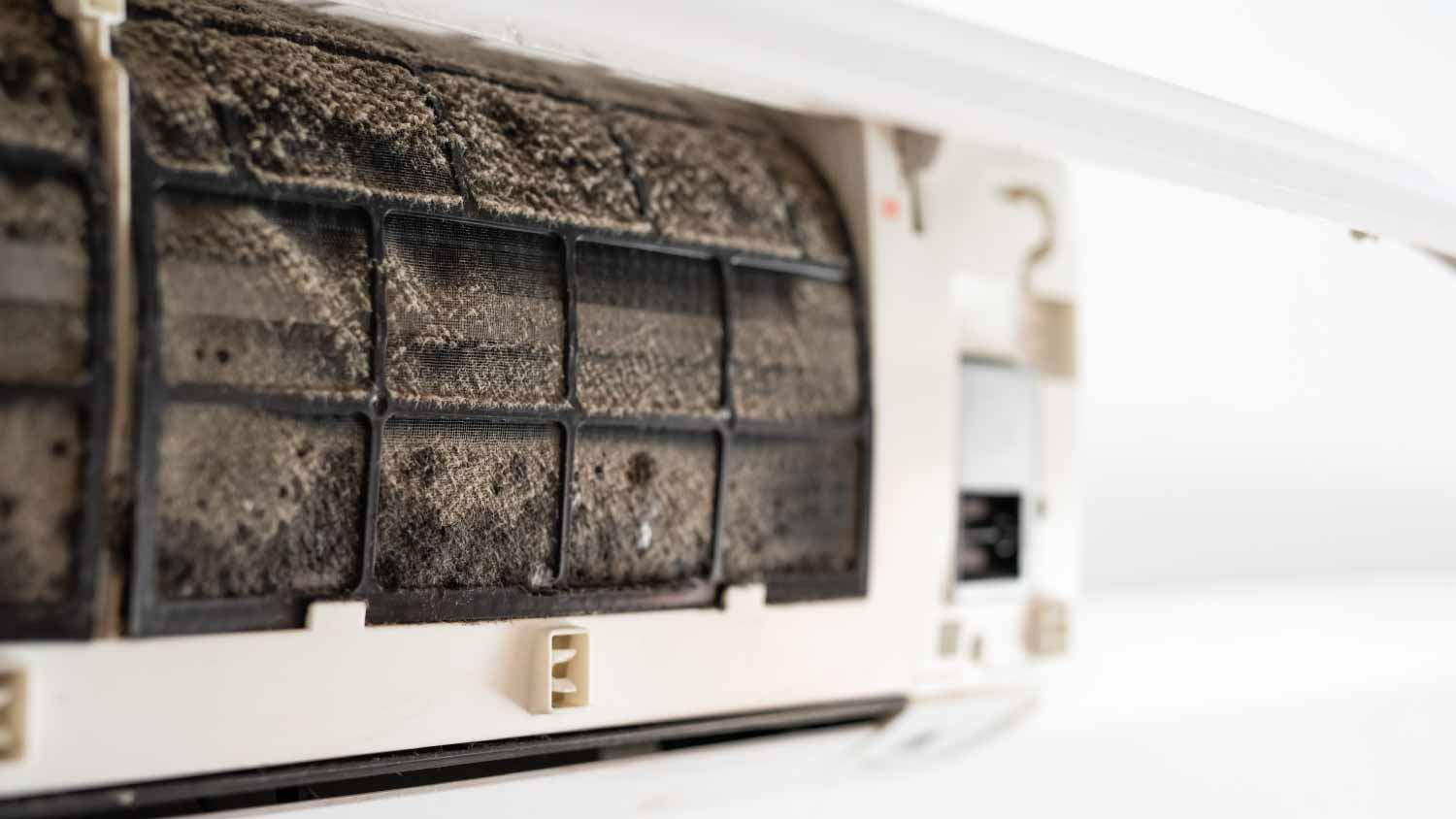6 Signs of Mold in Your Air Conditioner (and How to Get Rid of It)
Itchy, sneezing, watery eyes? There may be a fungus afoot.


A distinctive, musty smell can signal mold in your air conditioner.
Look for fuzzy patches or black dust in or around the vents, filters, and ducts.
Respiratory symptoms such as coughing, a sore throat, or congestion can be signs of a mold infestation.
You may be able to clean spots of mold in your air conditioner yourself, but more severe problems require an HVAC specialist.
Sorry to break it to you, but that “summer cold” might not be a cold at all. It could be a sign of mold in your air conditioner. If you’ve been sneezy or wheezy, you could be experiencing symptoms of mold infestation. Learn what other signs to look for in and around your air conditioner so that you can avoid health problems caused by mold and restore fresh, clean air to your home.
Why Mold in Your AC Is Dangerous
Exposure to mold can lead to many negative health effects. According to the Centers for Disease Control and Prevention, some people may experience rashes, burning eyes, and wheezing. Others with more sensitive allergies could experience severe reactions, and those with weaker immune systems can get chronic lung infections or diseases.
Mold isn’t something to take lightly, even if it’s not widespread. If you have any of these signs of mold in your AC, it’s safest to reach out to a local mold removal pro or HVAC repair specialist for an inspection and expert removal.
1. Funny Smell
One of the first signs of mold in your air conditioner is a funny smell when you turn it on. It will be a musty, funky, distinctive smell caused by mold and mildew spores within the unit. The smell will likely be stronger when the air is blowing, but it’s possible that the smell can linger even when the AC is turned off.
2. Fuzzy Patches

If you see fuzzy patches, that’s a definite sign you have mold. It means the spores have landed and begun to grow. Mold patches are fuzzy and green, blue, white, pink, or yellow, depending on what type of mold it is. You might see these mold growths on the vent, the filter, the evaporator coils, or in the drip pans.
3. Black Dust
If you spot what looks like black dust, it means the mold in your air conditioner is likely black mold, which can cause troublesome health problems for those with mold allergies. Black mold, or Stachybotrys chartarum (S. chartarum), is a dark-colored fungus that thrives on warmth and moisture.
The terms “mold,” and “black mold" are commonly used interchangeably, but there is a difference. Black mold is a specific type of mold. It’s typically black in color, but it can be green. And, unlike some types of mold, black mold is toxic.
4. Coughing and Wheezing

Mold in your air conditioner can cause respiratory symptoms, including coughing and wheezing. These problems can be worse in people with asthma or mold allergies, as they’re already more susceptible to breathing trouble. If your symptoms are worse while you’re inside, mold is an especially likely culprit.
5. Eye, Nose, and Throat Irritation
Allergy-type symptoms, including itchy, watery eyes, a stuffy or runny nose, sneezing, and sore throat, can all indicate mold irritation. This is because mold and the microbial volatile organic compounds (mVOCs) it releases can cause inflammation of the eyes, nose, and throat.
6. Illness

Mold can also lead to sinus infections and make you more susceptible to pneumonia, bronchitis, asthma attacks, and other illnesses.
How to Prevent Mold in Your Air Conditioner
It’s possible to prevent mold in your air conditioner by properly maintaining your AC unit. The main goal is to reduce excess moisture and avoid stagnant air or water. Keeping up with the following tasks will help:
Drain the line: Make sure you know how to clean the AC drain line. A clogged drain line prevents evaporated water from freely flowing away from the unit. (It can also be a cause of your AC freezing up.)
Empty the tank: For portable units, you may need to remove the drain plug to empty the water drain tank or reservoir and avoid standing water.
Wash or replace filters: Be sure to replace disposable AC filters or clean washable filters to remove mold spores. Your appliance manual should tell you how often to perform this task, but it’s likely once a month.
Clean registers: Keep your AC registers clean to prevent excess debris from creeping into your ductwork and to allow completely clear airflow throughout your home.
Can I DIY Air Conditioner Mold Cleaning?
For portable and window AC units, you should be able to clean the mold on your own. The best way to clean the mold from your air conditioner is to clean it in a separate area, preferably outside, wearing gloves and eye protection. Scrub the affected areas with detergent and water, and don’t be afraid to use a little extra elbow grease. Then, dry the area completely. If the filter has mold in it, throw the filter away and buy a new one.
The U.S. Environmental Protection Agency does not recommend cleaning mold with bleach. Stick to detergent and water for cleaning mold spots.
If you have central air conditioning, DIY is not the best idea. Instead, call a local air conditioning repair pro or mold remediation specialist. They’ll know what to look for and how to access the different parts of your system, including ducts, vents, and the exterior unit.
Frequently Asked Questions
It depends on the type of air conditioner you have. You can expect a window air conditioner to last eight to 10 years, a portable AC unit to last five to 10 years, and a ductless air conditioner or mini-split system to last up to 20 years. For central air, the average life span is 10 to 15 years, but some systems have been known to last 30 years.
It costs an average of $7,500 to replace an HVAC system, although you may pay up to $12,500. The final price depends on the brand and size of the unit you buy, in addition to labor costs. In contrast, the average price of AC repair is $350. However, if you’re dealing with problems such as a broken AC compressor or a refrigerant leak, repairs can be much higher, averaging between $225 and $2,800.





- Furnace Repair
- Air Conditioning Repair
- HVAC Repairs
- Furnace Installation
- Wood & Pellet Stove Repair
- Dehumidifier & Humidifier Repair
- Heat Pump Companies
- Swamp Cooler Repair
- Wood Stove Services
- HVAC Companies
- Commercial A/C Repair
- Geothermal Installation
- Air Conditioning Installation
- Boiler Repair
- 24 Hour Furnace Repair
- Geothermal Repair
- Heat Pump Repair
- Humidifier Installation
- Thermostat Repair
- Thermostat Installation
- Nest Installation
- Heating & Cooling
- Heating Repair
- Furnace Cleaning
- Furnace Tune-Up
- HVAC Technicians
- Subcontractors
- Furnace Maintenance
- Plumbing & Heating Companies
- Wood Stove Inspection
- Mini Split Installation
- Wall Heater Repair
- Duct Installers
- Black Mold in Your Air Ducts: Symptoms, Signs, and Prevention
- 7 Possible Symptoms of Mold in Your Air Ducts
- How to Test for Mold in Your Home
- 12 Signs of Mold in Your House and What to Do About It
- How to Get Rid of Mold From Every Surface in Your Home
- How to Prevent Mold Growth in an Air Conditioner
- 5 “Natural” Mold Killers: How They Work and What They Can Actually Clean
- What Causes Mold in Your House?
- How to Get Rid of Mold in Your Basement
- Do Dehumidifiers Prevent Mold?












